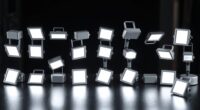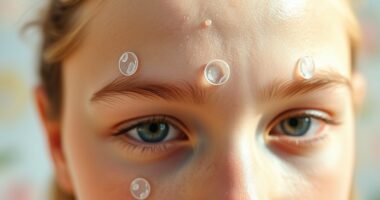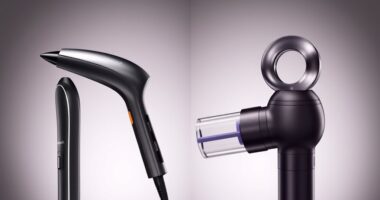I’ve found the top 15 diffraction grating nano-imprint samples that showcase cutting-edge technology, from high-density 13,500 lines/inch sheets to versatile roll formats and double-axis designs. These samples feature advanced materials for superior optical clarity, durability, and precision, perfect for educational, research, and creative uses. They demonstrate the latest in nano-imprint technology, ensuring high resolution and excellent spectrum separation. Keep exploring to discover more about these innovative diffraction gratings and how they can enhance your experiments.
Key Takeaways
- Showcase high-resolution diffraction patterns highlighting advanced nano-imprint techniques with line densities up to 13,500 lines/inch.
- Demonstrate cutting-edge optical performance through durable, holographic, and diffraction-grade materials suitable for precise spectral analysis.
- Feature innovative designs like double-axis gratings and large-format samples for versatile nano-imprint applications.
- Include examples of reusability and durability in nano-imprint diffraction samples under environmental stress.
- Highlight integration of nano-imprint gratings in modern photonic, sensor, and optical research technologies.
Bartovation Diffraction Grating Sheet 1,000 Lines/mm [One 6 x 1ft Sheet]
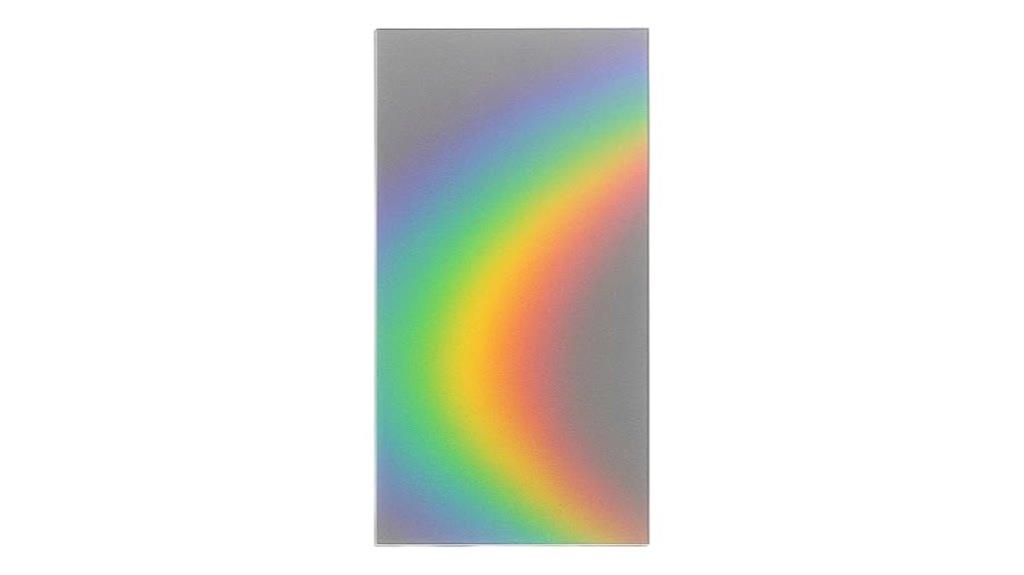
If you’re looking for a high-quality diffraction grating for educational or research purposes, the Bartovation Diffraction Grating Sheet 1,000 Lines/mm is an excellent choice. This 6-inch by 12-inch sheet delivers precise, sharp diffraction patterns with minimal noise, making spectral analysis clearer. Its high line density allows detailed observation of light spectra from various sources, including gas tubes. Plus, it’s reusable—if kept clean and flat—making it cost-effective. Whether for teaching physics or conducting experiments, this diffraction grating enhances your ability to visualize and analyze light behavior accurately, providing high-quality results every time.
Best For: physics educators, students, and researchers seeking precise, high-resolution diffraction patterns for spectral analysis and light behavior demonstrations.
Pros:
- Provides sharp, high-quality diffraction patterns with minimal noise for clear spectral observation
- High line density (1,000 lines/mm) allows detailed analysis of light spectra from various sources
- Reusable when kept clean and flat, making it a cost-effective educational and research tool
Cons:
- Requires careful handling to avoid creases and damage, which can affect performance
- Limited size (6 inches x 12 inches) may not accommodate large-scale experimental setups
- May need additional equipment or light sources for optimal spectral analysis in some applications
Bartovation Diffraction Grating Sheet 13,500 Lines/in [One 6 x 5ft Roll]
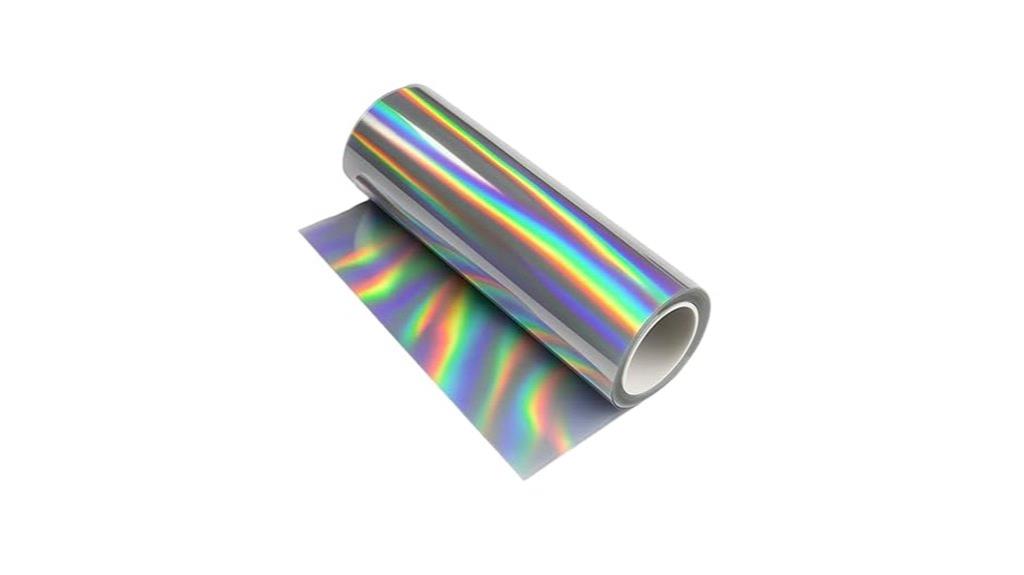
The Bartovation Diffraction Grating Sheet with 13,500 lines per inch is an excellent choice for educators and researchers seeking high-resolution spectral analysis. Its generous 6″ x 5-ft size provides ample surface area for multiple experiments or demonstrations. The double-axis design enhances diffraction efficiency, making spectral details clearer. It’s reusable, but requires careful cleaning and handling to prevent crinkles that could affect performance. Perfect for viewing spectra from gas tubes and various light sources, this grating sheet is ideal for physics education and visual diffraction displays. It offers precise, vibrant color separation essential for advanced spectroscopy and teaching applications.
Best For: physics educators, researchers, and spectroscopy enthusiasts seeking high-resolution spectral analysis and vivid diffraction displays.
Pros:
- High line density of 13,500 lines per inch for detailed spectral resolution
- Double-axis design enhances diffraction efficiency and clarity
- Reusable and durable with proper cleaning and handling
Cons:
- Requires careful cleaning to prevent crinkles that can affect performance
- Larger size may be cumbersome for small or portable setups
- Handling and storage must be meticulous to maintain quality over multiple uses
13,500 Lines/inch Diffraction Grating Sheet – Double Axis [1 x 6]
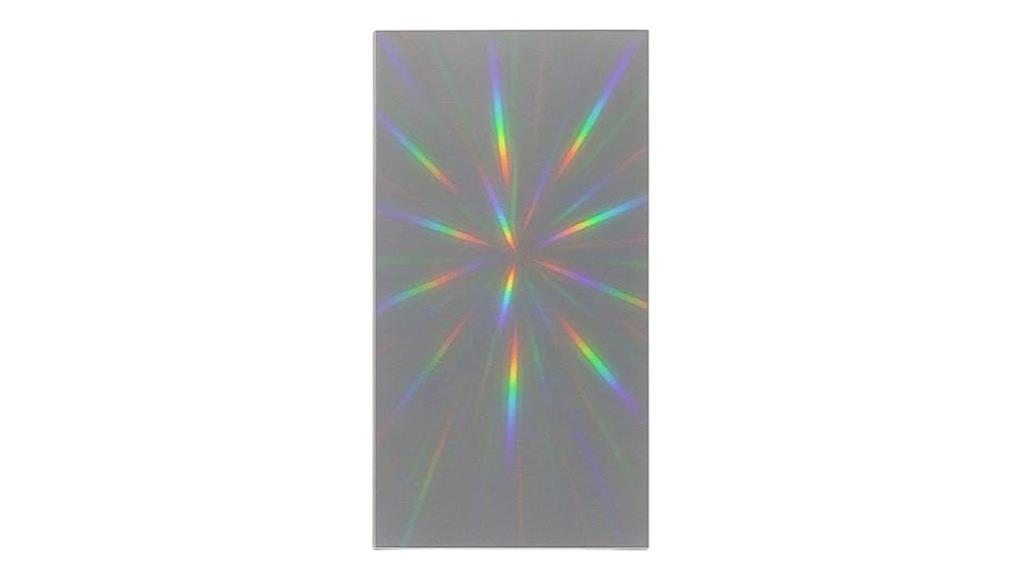
A 500 Lines/inch Diffraction Grating Sheet with double axis design offers exceptional precision and clarity, making it ideal for advanced educational and scientific applications. Its 6” x 12” size provides ample space for thorough spectrum analysis, while the double axis structure enhances diffraction accuracy and detail. Designed to minimize noise, it delivers clear, vibrant color spectra from various light sources, including gas tubes. This sheet is reusable, maintaining optical quality when kept clean and free of crinkles. Its high-quality construction ensures reliable, repeatable results, making it a valuable tool for physics experiments, light diffraction displays, and detailed spectrum observations.
Best For: physics educators, students, and researchers seeking precise, reliable spectral analysis and detailed light diffraction displays.
Pros:
- High line density of 13,500 lines/inch enables detailed spectrum resolution
- Double axis design improves diffraction accuracy and clarity
- Large 6” x 12” sheet size allows comprehensive spectrum observation
Cons:
- Requires careful handling to prevent crinkles and maintain optical clarity
- Higher line density may be more expensive than lower-density gratings
- Not suitable for applications requiring extremely fine or ultra-high resolution beyond 13,500 lines/inch
Rainbow Symphony Diffraction Grating Slides (Package of 10)
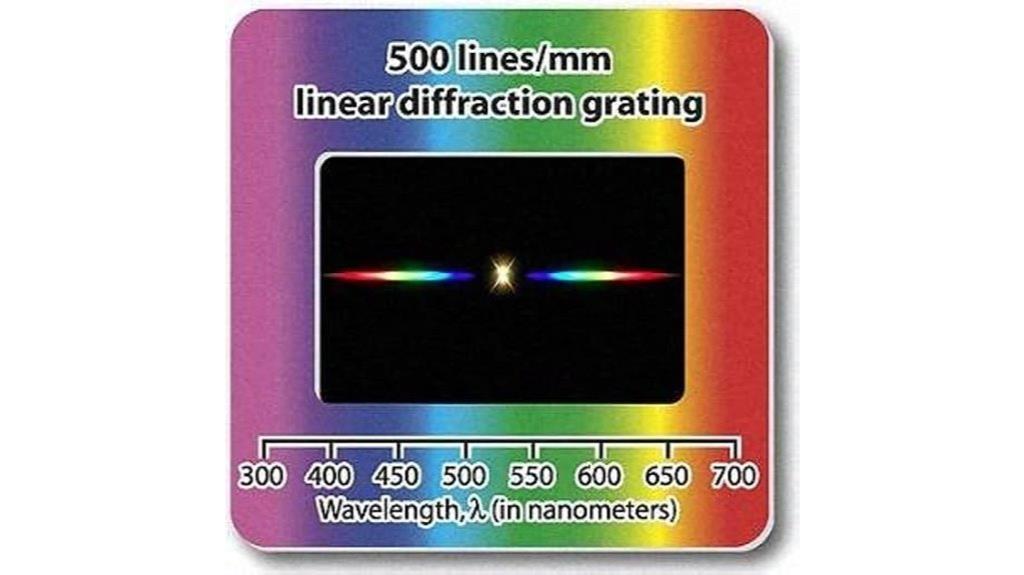
Designed for educators and students, Rainbow Symphony Diffraction Grating Slides (Package of 10) offers a reliable and affordable way to explore light spectra. These 2×2-inch slides feature holographic diffraction gratings with 500 lines per millimeter, producing bright, detailed spectra with minimal noise. Made in the USA, they’re compatible with overhead and 35mm projectors, making spectrum demonstrations simple and effective. Ideal for classroom experiments, they help visualize diffraction, analyze light sources, and measure wavelengths. Though they require careful handling, these gratings are durable, cost-effective, and perfect for hands-on learning, especially when paired with colored gels for engaging color experiments.
Best For: educators, students, and STEM enthusiasts seeking a cost-effective, durable tool for visual spectrum analysis and light diffraction experiments.
Pros:
- Produces bright, detailed spectra with minimal noise for clear visualization
- Compatible with overhead and 35mm slide projectors, enhancing demonstration versatility
- Made in the USA with high-quality holographic elements, ensuring durability and reliable performance
Cons:
- Requires careful handling to avoid fingerprints and damage to the film surface
- Loose mounting in holders may necessitate additional mounting for precise experiments
- Not suitable for high-powered lasers due to plastic construction and potential damage risk
Diffraction Grating Set for Optics Experiments (Pack of 5)

If you’re looking for a versatile diffraction grating set for physics experiments or classroom demonstrations, this pack of five grids offers an excellent solution. It includes a single slit grid, double slit grid, round hole grid, mesh grid, and composite grid, providing an all-encompassing toolkit for exploring optical phenomena. Each grid has precise seam widths—ranging from 0.05mm to 0.2mm—and slit spacings from 0.2mm to 0.45mm—ensuring accurate diffraction results. Made from lightweight, durable plastic, they’re easy to handle and ideal for various research and teaching scenarios. With dimensions of 50x50mm, these grids are compatible with most optical setups.
Best For: physics students, educators, and researchers seeking comprehensive optical diffraction experimentation tools.
Pros:
- Includes five different grids for versatile experiments and demonstrations
- High precision seam widths and slit spacings ensure accurate diffraction results
- Made from lightweight, durable plastic for easy handling and longevity
Cons:
- Dimensions may limit use with larger optical setups
- Sizing details should be carefully reviewed to ensure compatibility with specific projects
- Limited to optical diffraction experiments, not suitable for applications outside optics
Bartovation Diffraction Grating Sheet 500 Lines/mm [One 6 x 1ft Sheet]
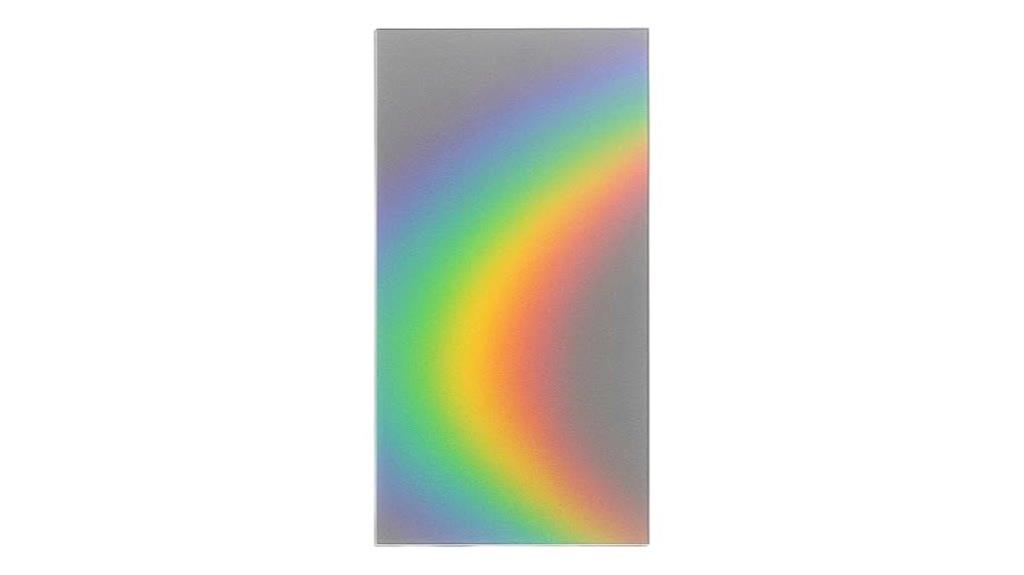
The Bartovation Diffraction Grating Sheet 500 Lines/mm is an excellent choice for educators and researchers who need precise and clear spectral analysis. Its 6-inch by 12-inch size offers ample space for observing light spectra from various sources. Designed to produce minimal noise, it ensures sharp, vivid color separation, making spectral details easy to analyze. This diffraction grating can be reused multiple times if kept clean and free of wrinkles, maintaining its accuracy. Perfect for physics experiments, educational demonstrations, and spectroscopic studies, it provides high clarity and durability, helping users explore the fascinating world of light and spectra with confidence.
Best For: educators, students, and researchers seeking precise, clear spectral analysis for physics experiments and spectroscopic demonstrations.
Pros:
- Produces minimal noise for sharp, vivid color separation
- Large size (6″ x 12″) allows for versatile observation of various light sources
- Reusable with proper cleaning, maintaining high accuracy over time
Cons:
- Requires careful handling to avoid wrinkles or surface contamination
- Limited to linear diffraction at a single axis, restricting certain experimental setups
- May not be suitable for high-intensity or industrial applications
Bartovation Diffraction Grating Sheet 1,000 Lines/mm [One 6 x 5ft Roll]
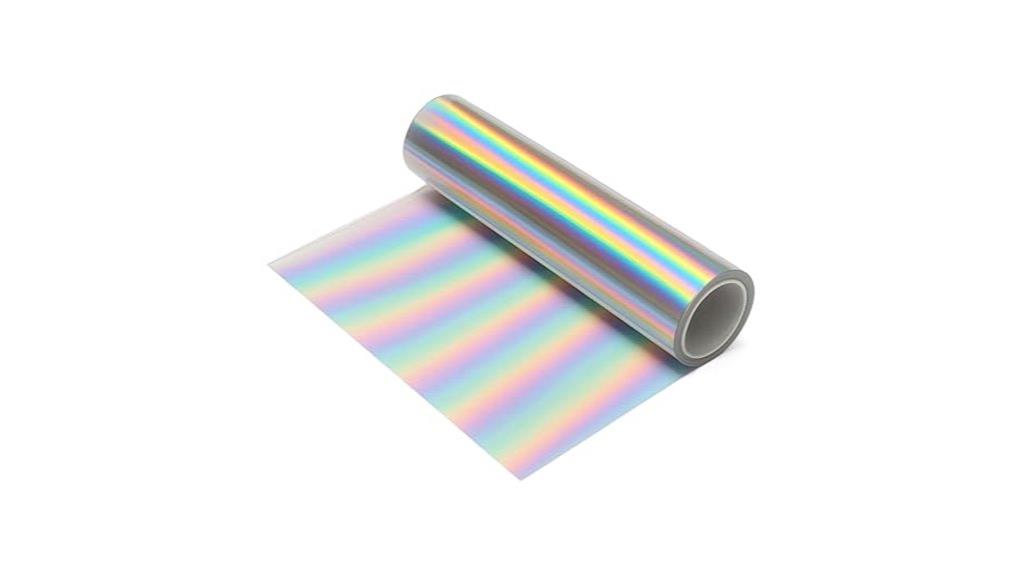
The Bartovation Diffraction Grating Sheet with 1,000 lines per millimeter is ideal for educators and scientists who need high-resolution spectral analysis. Measuring 6 inches by 5 feet, it offers a single axis with dense lines that produce detailed, clear spectra. This sheet is reusable, provided it stays clean and free of crinkles, making it cost-effective for multiple experiments. It’s perfect for physics classes and research, enabling direct observation of light diffraction from various sources. With minimal noise and high precision, it allows me to analyze colors accurately and demonstrate complex optical phenomena effortlessly.
Best For: educators and scientists seeking high-resolution, reusable diffraction grating sheets for detailed spectral analysis and optical demonstrations.
Pros:
- Provides high-resolution diffraction with 1,000 lines per millimeter for precise spectral detail
- Reusable and durable when kept clean and free of crinkles, offering cost-effectiveness
- Large 6-inch by 5-foot size allows for multiple experiments and demonstrations
Cons:
- Requires careful handling to prevent crinkles that could interfere with spectral clarity
- Limited to single-axis diffraction, which may not suit all experimental needs
- Needs to be kept clean to maintain optimal performance, potentially adding maintenance steps
Rainbow Symphony Diffraction Grating (25 Pack)

Designed for educators and party hosts alike, the Rainbow Symphony Diffraction Grating (25 Pack) offers a vibrant and cost-effective way to explore light and color phenomena. These diffraction peepholes feature 13,500 lines per inch, breaking light into spectral components when you look through them at any light source. Made in the USA from durable holographic lenses, they deliver vivid rainbow colors and mesmerizing spectral patterns. Perfect for classroom demonstrations or party entertainment, each 1 11/16-inch diffraction circle is housed in heavy cardboard for longevity and portability. Supplied in packs of 25, they’re ready for immediate use, combining quality with affordability.
Best For: educators, students, party hosts, and anyone interested in exploring the science of light and color phenomena.
Pros:
- Vibrant rainbow colors and mesmerizing spectral patterns for engaging demonstrations and entertainment.
- Made from durable, reusable holographic diffraction lenses crafted in the USA, ensuring quality and longevity.
- Convenient 1 11/16-inch size housed in heavy cardboard packaging for portability and easy handling.
Cons:
- Not suitable for viewing the sun directly due to the strength of the diffraction grating.
- Requires a light source to produce visible spectral effects; no illumination included.
- May be less effective with very diffuse or low-intensity light sources, reducing the clarity of rainbow patterns.
Diffraction Grating Sheet for Sun Catchers

If you’re looking to create eye-catching sun catchers that produce vibrant rainbows, a diffraction grating sheet is an excellent choice. Made from transparent, diffraction-grade material, it easily cuts with household scissors, making DIY projects simple. You can attach it with tape or other methods—no adhesive needed. Ideal for decorating windows, it transforms sunlight into colorful displays and adds a magical touch to your space. Each sheet comes in a reusable tube, ensuring safe storage and longevity. Perfect for crafting rainbow sun catchers, diffraction glasses, or even holographic treats like chocolate, it’s a versatile tool for creative, visually stunning projects.
Best For: DIY enthusiasts, educators, and crafters seeking to create vibrant rainbow displays and decorative sun catchers with easy-to-use, diffraction-grade materials.
Pros:
- Creates stunning rainbow effects when light passes through, enhancing visual appeal.
- Easily cut with household scissors, making it simple for DIY projects.
- Comes in a reusable storage tube for safe keeping and long-term use.
Cons:
- No adhesive included, requiring additional materials like tape for attachment.
- Not suitable for privacy purposes as it is transparent.
- Limited to decorative and visual enhancement uses rather than functional applications.
Diffraction Grating Sheet with 13,500 Lines/Inch
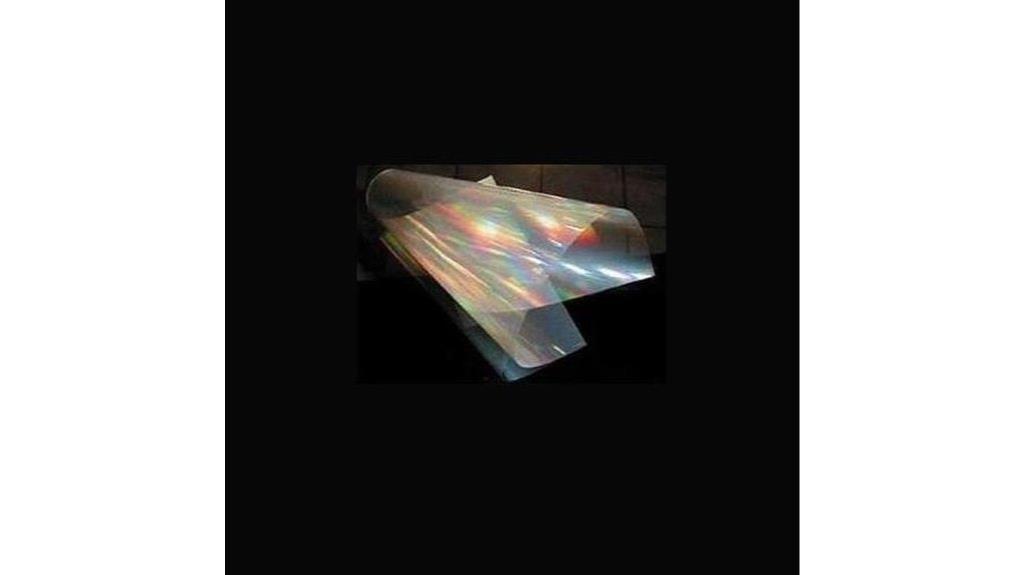
For educators and researchers seeking high-precision spectrum analysis, the diffraction grating sheet with 13,500 lines per inch offers exceptional resolution. Its double-axis design allows for detailed spectral separation, making it ideal for studying light sources and gas tubes. Each 6-inch by 60-inch sheet can be rolled and reused multiple times if kept clean and crinkle-free, ensuring durability. Produced to minimize noise, it provides a clear, vibrant color spectrum essential for accurate analysis. This sheet is a crucial component in spectroscopes and physics experiments, helping users deepen their understanding of light diffraction and spectral phenomena.
Best For: educators, researchers, and physics enthusiasts seeking high-resolution, reusable diffraction grating sheets for detailed spectrum analysis and light diffraction experiments.
Pros:
- High density of 13,500 lines per inch ensures exceptional spectral resolution
- Double-axis design enables comprehensive spectral separation for accurate analysis
- Reusable and durable when kept clean and crinkle-free, providing long-term value
Cons:
- Requires careful handling and cleaning to maintain optimal performance
- May be more expensive than lower-resolution diffraction gratings
- Limited to applications involving visible light spectrum, not suitable for other wavelengths
Diffraction Grating 50/100/300/600 Lines 2mm Spectrophotometer Optical Experiment

This diffraction grating spectrophotometer is perfect for students and educators seeking an accessible, reliable tool to explore light diffraction and spectral analysis. It offers options of 50, 100, 300, and 600 lines per millimeter, making it versatile for various experiments. Made from durable PET plastic, its lightweight, compact design (38x36mm, 2mm thick) is easy to handle and store. Ideal for teaching demonstrations, it helps users visualize spectral patterns and understand light behavior. Whether for classroom activities or hands-on experiments, this device simplifies complex optical concepts, providing a practical and effective tool for exploring the fundamentals of spectroscopy.
Best For: educators, students, and science enthusiasts seeking an easy-to-use, versatile tool for exploring light diffraction and spectral analysis in classroom or laboratory settings.
Pros:
- Durable PET/plastic construction ensures longevity and repeated use
- Lightweight and compact design facilitates easy handling, storage, and transportation
- Multiple grating options (50, 100, 300, 600 lines/mm) support a variety of spectroscopy experiments
Cons:
- Limited to educational and demonstration purposes; not suitable for advanced research
- Small size may require careful handling to avoid damage or loss
- Price and availability may vary, and additional accessories might be needed for complex setups
Rainbow Symphony Color Slides Set of 8
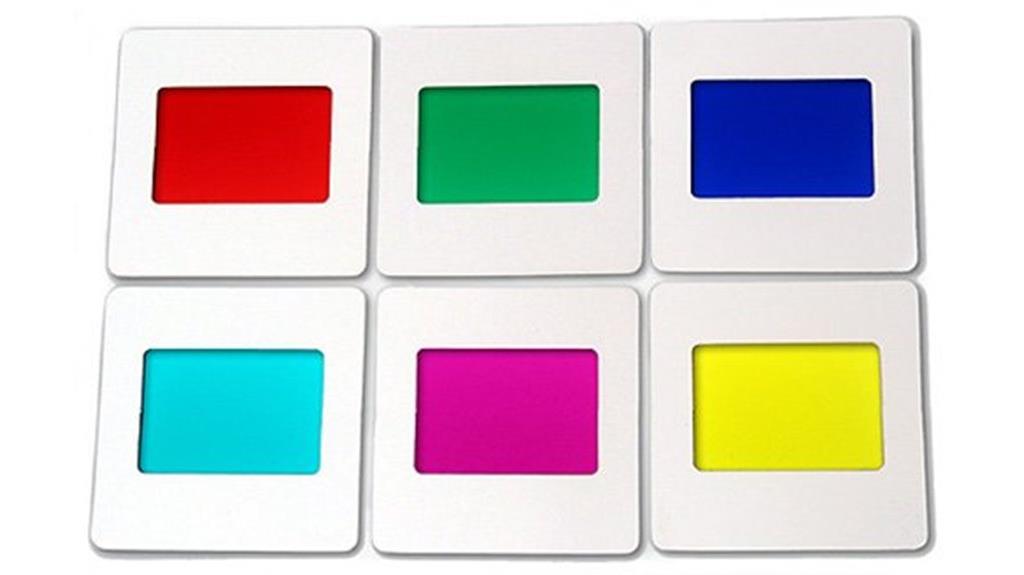
The Rainbow Symphony Color Slides Set of 8 offers a versatile collection ideal for educators and science enthusiasts enthusiastic to explore optical phenomena. It includes three diffraction grating slides—double axis, linear single axis, and an unspecified type—perfect for demonstrating diffraction and light behavior. Additionally, the set features six vibrant color slides—red, green, blue, cyan, yellow, and magenta—ideal for illustrating how light interacts with different wavelengths. Designed for educational and scientific use, these slides help visualize spectra, diffraction patterns, and color mixing. They’re a valuable tool for anyone looking to deepen their understanding of optics through engaging, hands-on demonstrations.
Best For: educators, students, and science enthusiasts interested in exploring optical phenomena through vibrant color displays and diffraction demonstrations.
Pros:
- Includes a variety of diffraction grating slides (double axis, linear single axis, and unspecified) for comprehensive optical experiments
- Features a colorful set of slides (red, green, blue, cyan, yellow, magenta) to demonstrate light interactions and color mixing
- Designed specifically for educational and scientific purposes, enhancing visual learning and understanding of optics
Cons:
- Limited to optical demonstration uses, not suitable for professional or industrial applications
- The set may require additional equipment or light sources for optimal use
- Some users might find the unspecified diffraction grating slide less clearly defined or detailed
Diffraction Grating, Pack Of 12
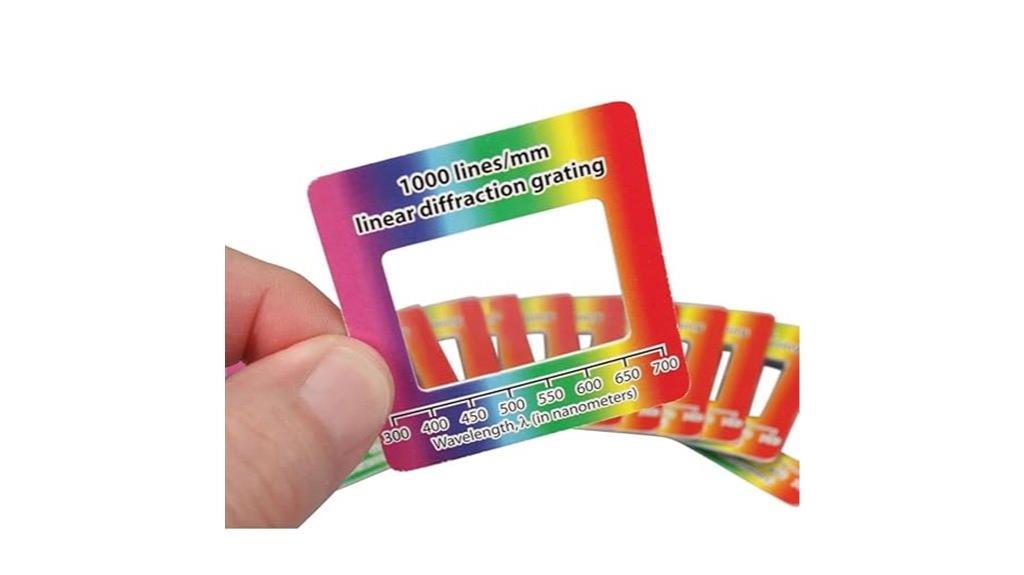
If you’re starting with spectral experiments or need an affordable diffraction grating, the Diffraction Grating Pack of 12 offers an excellent solution. These linear gratings have 1,000 lines/mm and come mounted in a standard 2 x 2 holder, making them easy to use. They effectively split white light into its component wavelengths, providing clear, sharp spectral separation. Unlike glass prisms, these gratings are more durable and won’t break if dropped. Sold in packs of 12 slides, they’re perfect for beginners or educational setups, offering reliable performance at a budget-friendly price. This pack ensures you have plenty for multiple experiments or group demonstrations.
Best For: beginners and educators seeking an affordable, durable diffraction grating for introductory spectral experiments and group demonstrations.
Pros:
- Provides clean and sharp spectral separation of light components
- Durable and less fragile than glass prisms, reducing breakage risk
- Easy to use with standard 2 x 2 mounting holder and sold in convenient packs of 12
Cons:
- Limited to basic spectral analysis; may not be suitable for advanced research
- Slightly lower resolution compared to high-end gratings with more lines/mm
- The plastic mounting may be less sturdy over time than metal holders
Pack of 5 Diffraction Grating Sheets (13,500 l/inch)
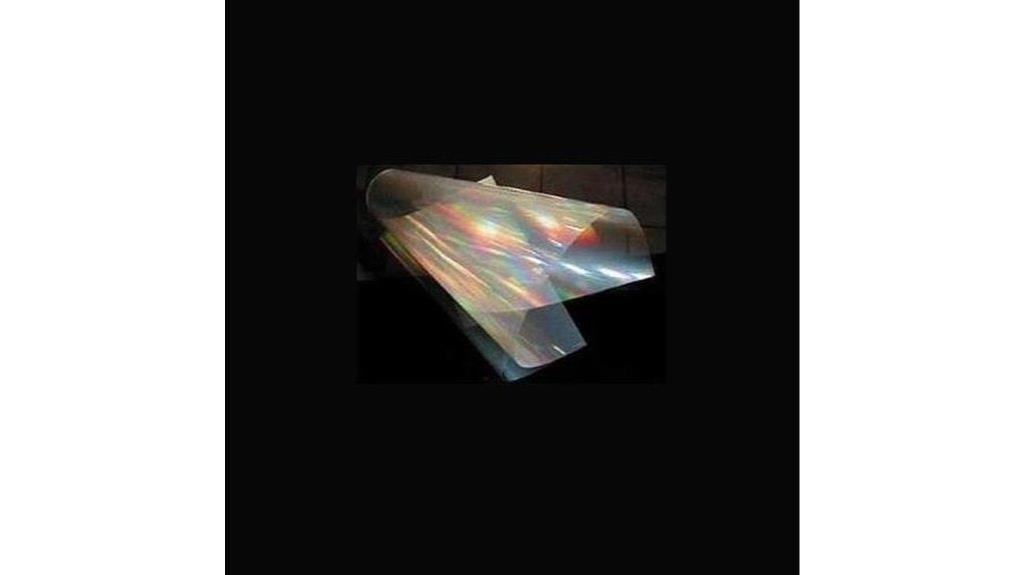
For educators and hobbyists seeking reliable diffraction gratings for optical experiments, the pack of five 13,500 lines per inch sheets offers an excellent solution. Each sheet measures 1 foot by 6 inches and is perfect for classroom projects, rainbow displays, or pattern transfers. Users have successfully created rainbow spy glasses, layered sheets for safety goggles, and projected vivid rainbows on walls. While some sheets arrived damaged or with fingerprints, overall, they meet specifications when undamaged. Proper packaging, like sturdy tubes, can help prevent shipping damage. These sheets are versatile, effective, and valuable for engaging optical demonstrations and experiments.
Best For: educators, hobbyists, and DIY enthusiasts seeking high-quality diffraction gratings for classroom experiments, optical demonstrations, and creative projects.
Pros:
- Provides high line density of 13,500 lines per inch for detailed diffraction patterns
- Versatile for various applications including rainbow displays, lens creation, and safety goggles
- Generally meets specifications when undamaged, offering reliable optical performance
Cons:
- Sheets are thin and prone to dents, creases, or damage during shipping if not properly protected
- Some sheets may arrive with fingerprints, nicks, or other imperfections that affect usability
- Packaging methods (thin bags or polymailers) can lead to shipping damage, requiring sturdier packaging solutions
Diffraction Grating sheet 13,500 lines/inch – Double Axis 1Ft x 6 Inches

This diffraction grating sheet with 13,500 lines per inch and a double-axis configuration is ideal for professionals and educators seeking precise spectral analysis. Its 6-inch by 12-inch size offers ample surface area for detailed experiments. The double-axis design minimizes noise, ensuring clear, sharp color spectra. It’s perfect for viewing spectra from gas tubes and various light sources, making it a versatile tool for physics demonstrations and education. This reusable sheet maintains high performance when kept clean and free of crinkles. Overall, it enhances both educational experiences and experimental accuracy, providing reliable and high-quality spectral observations for advanced and instructional applications.
Best For: educators, physics students, and professionals conducting detailed spectral analysis and light diffraction experiments.
Pros:
- Provides high-resolution spectral data with 13,500 lines per inch for precise analysis
- Double-axis design minimizes noise for clearer and sharper spectra images
- Reusable and durable, maintaining performance with proper care and cleanliness
Cons:
- Requires careful handling to avoid crinkles that could affect performance
- Limited size (6″ x 12″) may restrict large-scale or multiple simultaneous experiments
- May be more expensive than simpler diffraction gratings due to its high quality and detailed design
Factors to Consider When Choosing Diffraction Grating Nano‑Imprint Samples
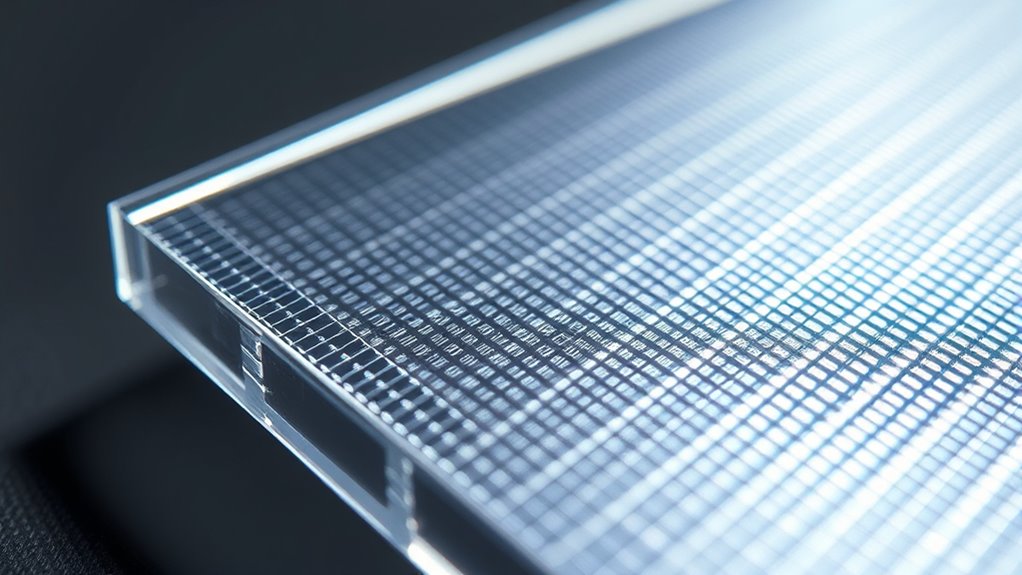
When selecting diffraction grating nano-imprint samples, I focus on key factors like line density precision and material durability to guarantee performance and longevity. Optical clarity and noise reduction features are also critical for high-quality results, while reusability can save time and costs. Considering these points helps me choose the best sample for my specific application needs.
Line Density Precision
Selecting diffraction grating nano-imprint samples with precise line density is essential for achieving accurate spectral measurements. Higher line densities, like 13,500 lines per inch, provide finer spectral resolution and more detailed diffraction patterns. Precise line density ensures consistent measurements, reducing errors caused by manufacturing variations or inaccuracies. Even small differences—just a few lines per millimeter—can considerably affect the clarity and accuracy of spectral analysis. Accurate specifications help match the grating to specific experimental needs, such as wavelength range or spectral detail. Additionally, uniform and well-calibrated line density across the entire surface is critical. This consistency guarantees reliable, reproducible results, which are crucial for advanced spectroscopic applications. Ultimately, precision in line density directly impacts the quality of your diffraction and measurement outcomes.
Material Durability
Material durability plays a essential role in choosing diffraction grating nano-imprint samples because it directly affects their longevity and performance. A robust material can withstand repeated handling, cleaning, and environmental exposure without degrading optical qualities. High-quality options like polymer composites or holographic films are more resistant to scratches, tears, and chemical damage, ensuring the sample remains functional over time. Resistance to UV radiation and moisture is especially important for outdoor or humid environments, helping maintain stability and prevent optical performance loss. Resilient materials also retain their line density and diffraction efficiency, preserving spectral resolution and accuracy. Additionally, selecting sturdy materials enhances reusability, allowing multiple experiments without needing frequent replacements. Ultimately, durability ensures reliable, long-term performance in demanding conditions.
Optical Clarity
Optical clarity in diffraction grating nano-imprint samples hinges on the precision of the holographic or ruled lines, which must be free from distortions and imperfections. High-quality samples feature smooth, uniform surfaces that reduce scattering and diffraction noise, resulting in sharper spectral separation. Surface cleanliness is essential—fingerprints, dust, or scratches can obscure the diffraction pattern and hinder visibility. Consistent line density and accurate fabrication techniques are critical, especially for high line counts like 13,500 lines per inch, to guarantee clear diffraction images. Proper handling and storage also play a role; physical damage or creases can degrade optical clarity over time. By paying attention to these factors, I guarantee the samples I choose deliver the best possible optical performance.
Noise Reduction Features
Noise reduction features are essential when choosing diffraction grating nano-imprint samples because they directly affect the clarity and accuracy of spectral patterns. Reducing background interference ensures faint or closely spaced spectral lines are clear and distinguishable. High-quality gratings often include anti-reflective coatings or are manufactured with precision techniques to minimize stray light and noise. Double-axis diffraction gratings tend to produce less noise compared to single-axis types due to their improved diffraction properties. Proper handling, cleanliness, and storage are also critical for maintaining noise reduction features over time. By focusing on these aspects, you can select samples that deliver sharper, more reliable spectral data, which is indispensable for precise analysis and cutting-edge research.
Reusability Potential
When selecting diffraction grating nano-imprint samples, considering their reusability potential is vital for cost-effectiveness and long-term performance. The material quality and resistance to wear and contamination are key factors—durable holographic or plastic gratings can often be reused multiple times if handled properly. Keeping the surface clean, free of fingerprints, dust, and crinkles, is essential to maintain their reusability. Proper storage, such as protective covers or flat placement, helps prevent damage and preserves performance over time. Additionally, the design, including adhesive backing and structural integrity, influences how many times a grating can be reused without degradation. Evaluating these factors ensures you select samples that deliver reliable, repeated performance, maximizing your investment and efficiency.
Compatibility With Devices
Choosing the right diffraction grating nano-imprint sample requires guaranteeing it seamlessly integrates with your device’s specifications. First, check that the sample’s size and form factor fit your optical setup. The line density should match your resolution needs, whether in lines per millimeter or inch. It’s also essential to verify that the mounting method aligns with your device’s attachment or insertion mechanisms. Additionally, confirm that the spectral range and diffraction angles produced are compatible with your measurement or observation capabilities. Finally, verify that the material and coating of the sample are suitable for your light sources and environmental conditions to prevent damage or degradation. Paying close attention to these factors guarantees peak performance and reliable results when incorporating the diffraction grating sample into your device.
Application Suitability
Selecting the right diffraction grating nano-imprint sample hinges on understanding whether its design aligns with your specific application requirements. First, check if the grating covers the wavelength range or spectral region you need. This guarantees maximum diffraction efficiency for your system. Next, evaluate the line density; higher densities offer better spectral resolution, which is vital for precise measurements. Consider the line orientation—single-axis or double-axis—based on whether your application demands specific diffraction patterns or measurement accuracy. Compatibility is also key: confirm that the grating’s size, mounting options, and materials fit your optical setup. Lastly, assess the sample’s durability and reusability, especially if you’ll use it repeatedly or in demanding environments. These factors help guarantee your chosen sample performs reliably in your specific application.
Frequently Asked Questions
How Do Diffraction Grating Samples Impact High-Precision Optical Measurements?
Diffraction grating samples markedly improve high-precision optical measurements by providing exceptional spectral resolution and accuracy. I’ve seen how advanced gratings reduce errors in spectrometry, allowing for precise analysis of light sources. Their nano-imprint technology creates uniform, high-quality patterns, which enhances measurement reliability. When I use these samples, I notice sharper spectral lines and better signal clarity, making my data more accurate and my experiments more dependable.
What Are the Manufacturing Differences Between Single-Axis and Double-Axis Diffraction Gratings?
Single-axis diffraction gratings are manufactured with line patterns aligned in one direction, simplifying the process and reducing costs. Double-axis gratings, however, have lines patterned in two perpendicular directions, making production more complex and requiring precise control to guarantee accuracy. I’ve found that double-axis gratings offer enhanced performance for multidimensional applications, but their fabrication demands advanced lithography and meticulous quality checks compared to single-axis versions.
How Do Environmental Conditions Affect the Performance of Nano-Imprint Diffraction Samples?
Environmental conditions critically influence nano-imprint diffraction samples. Humidity and temperature fluctuations can cause expansion or contraction, leading to distortions or defects in the nanostructures. Contaminants like dust or oils can degrade the surface quality, reducing efficiency. I always recommend maintaining a controlled environment with stable temperature, low humidity, and clean conditions to guarantee ideal performance and durability of these delicate samples.
Can Diffraction Gratings Be Customized for Specific Wavelength Ranges or Applications?
Yes, diffraction gratings can definitely be customized for specific wavelength ranges or applications. I work closely with clients to tailor the groove density, material, and overall design to match their unique needs. Whether it’s for ultraviolet, visible, or infrared applications, I guarantee the gratings are optimized for maximum efficiency and performance. Customization makes the technology more versatile, helping you achieve precise control over light manipulation in your projects.
What Are the Durability and Lifespan Considerations for Advanced Diffraction Grating Samples?
Imagine a delicate yet resilient spider’s web, shimmering with constant light. That’s how I view advanced diffraction gratings—designed to last, yet sensitive to environmental factors. Durability depends on material choice, coating quality, and usage conditions. When well-made, they withstand temperature shifts, humidity, and handling, ensuring a long lifespan. Regular inspection and proper storage are key to maintaining their cutting-edge performance over time, much like a finely spun web enduring the elements.
Conclusion
In exploring these diffraction grating delicacies, I discover dazzling designs that define cutting-edge creativity. From fine lines to fabulous features, these samples showcase superb sophistication and scientific skill. Selecting the right sheet depends on your specific needs, so I encourage you to contemplate clarity, count, and consistency. Immerse yourself in these dynamic displays, and let your discoveries dazzle with design, detail, and dedication. Don’t delay—delve into the world of diffraction and delight in the dazzling details!

